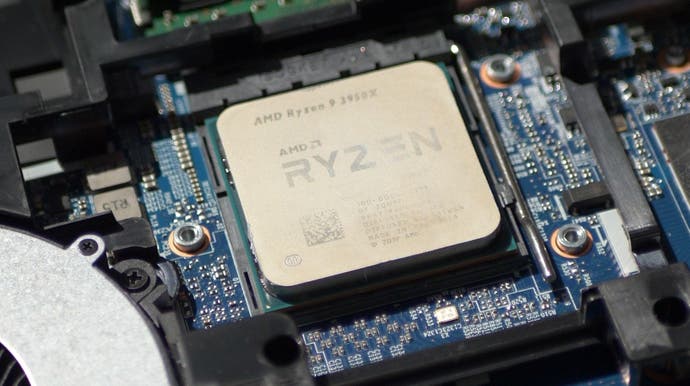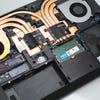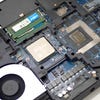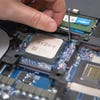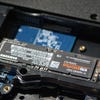XMG Apex 15 review: Ryzen 9 3950X in a laptop - and we're not kidding
Can AMD's flagship 16-core CPU actually work in a 15-inch notebook?
The AMD Ryzen 3950X processor has 16 cores and 32 threads, clocking up to a maximum of 4.7GHz. It's the flagship of AMD's super-successful Ryzen 3000 series and a CPU that demolished Intel's high-end desktop processor line-up. And now, as insane and impossible as it might sound, you can run it in a laptop - a 15-inch laptop, no less. So, let's have a moment of hushed awe for the XMG Apex 15, which must surely be the most powerful notebook available right now on the market - certainly in CPU terms. Going into this one, I had a range of questions. How can this possibly work? Why doesn't it just immediately overheat and shutdown?
Answers start to become clear when we consider the nature of the XMG Apex 15 beyond the CPU. Built by a firm that specialises in configurable notebooks, XMG - in common with other PC 'boutique' sellers - uses barebone designs from an ODM (original design manufacturer) which are then customised. This particular chassis is remarkable in that its mainboard is based on AMD's B450 chipset and retains the original AM4 socket, meaning that XMG can insert any desktop CPU in there you want when you order, and later on down the line, you can upgrade it yourself.
The firm was generous enough to supply a new Apex 15 for review kitted out with the Ryzen 9 3950X, 16GB of 3200MHz DDR4 and a Samsung 970 Evo Plus NVMe SSD. Beyond that, it's simplicity itself to remove the lower cover where you have nigh-on instant access to the innards - and there we see just how upgradable this machine is. The memory isn't soldered to the motherboard, you can swap in your own SODIMMs. Next to the NVMe drive is an empty slot for a second SSD, and there's even space for another SATA drive.
What you can't fail to notice is a ginormous copper cooling assembly, under which you'll find CPU and GPU. It looks daunting, but simply removing a power cable for one of the integrated fans, removing its accompanying screws and then loosening the numbered screws in the centre sees this ginormous cooling assembly lift out easily enough. Under that (and a well-judged layer of Thermal Grizzly Kryonaut thermal grease) you'll find pretty much the only non-upgradable component - the refreshed mobile version of the RTX 2070. Next to it resides the star of the show, the Ryzen 9 3950X, and it is indeed sitting in a normal AM4 socket. XMG also supplied us an OEM Ryzen 9 3900 for testing purposes. Put simply, accessing and upgrading this machine is a doddle - even swapping CPUs is easier than a desktop unit.
- Manufacturer information about the XMG Apex 15 is available here, with direct access to the various configuration options here.
In supplying the Ryzen 9 3900 for review, XMG also reveals how this technological miracle is achieved. The non-X 3900 is a 65W TDP part vs the standard 105W TFP in the desktop version. Compared to the full-fat model, you get the majority of the performance, but with a huge reduction in power draw. There is no such 65W model of the 3950X, however, so the BIOS of the notebook simply switches it into eco mode, enforcing a 65W limit. The real question is how much of the fully unlocked experience the laptop gives you - and the answers are surprising.
Of course, there are compromises in aiming to deliver proper desktop performance. First and foremost, it's in terms of form factor. The XMG Apex 15 is indeed a 15-inch notebook in terms of its X and Y dimensions, but it's significantly thicker and deeper than the usual notebook. What this does mean, however, is that you get full-size ports - including Ethernet - and they are situated to the left, the right and on the back of the unit. There, you get HDMI, USB-C (with video output support) and mini-Displayport. There's also the power input there, with XMG supplying a 230W external PSU, and for the Ryzen 9 3950X in gaming, it actually maxes out its capabilities.
Fully unleashed, this thing is monstrous. Even at 65W, the Ryzen chips are drawing much more power than most laptop parts, so the cooling assembly is stressed heavily under load. At full throttle it's very, very loud - there's no doubt about it. XMG's solution is simply to offer the user choice. In the custom control panel, there are four modes: power saving, quiet, entertainment and performance. Entertainment is the standard, while performance fully unlocks the processor (within the 65W limit, of course). I ran Cinebench R20 in both single thread and multi-core modes on both Ryzen 9 3900 and Ryzen 9 3950X and these are the results I got. In percentage terms, it does seem to be the case that the 3900 retains more of its performance the lower down the chain of modes you go, but then again, it is a chip specifically designed for the 65W power envelope.
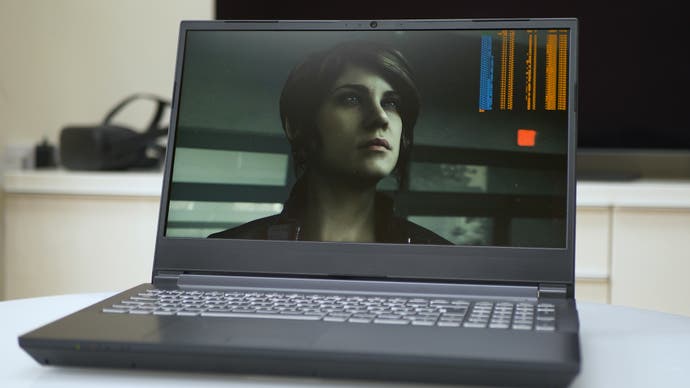
| Power Saving | Quiet Mode | Entertainment | Performance | |
|---|---|---|---|---|
| CineBench R20 3900 | 385/970 | 486/2628 | 490/5105 | 494/6474 |
| Cinebench R20 3950X | 267/1276 | 292/1971 | 454/4598 | 486/7501 |
I found the quiet mode to be perfectly serviceable for general PC tasks, but power-saving was not a particularly great experience at all. I also can't recommend the unit for running from battery power - the CPU clocks down massively on all cores and becomes far less responsive. There's only a 62WHr battery too, meaning that even with hobbled performance, you'll be very lucky indeed to get an hour's worth of use from the machine. This is unashamedly a desktop replacement though, and I consider the battery to be there simply to keep the machine active on the go before plugging it in somewhere else.
And when I say desktop replacement, I mean it. To get an idea of the basic power level of this machine, I switched into performance mode and ran Cinebench R20. I then stacked up the results with our desktop scores database and then added the Asus Zephyrus G14 laptop, based on the Ryzen 4000 'Renoir' APU (which has eight cores and 16 threads with a 35W TDP). The results are phenomenal: both 3900 and 3950X in the laptop beat Renoir in single-core performance and deliver a 55 per cent/79 per cent improvement in multi-core output. What's impressive here is that Renoir really is the state-of-the-art in mobile CPUs right now. The Apex 15 annihilates it.
But it's the desktop comparisons that are fascinating. We're not making life easier for the Apex 15 here - our library results are based on Ryzen chips that have no thermal limitations and run at full power. On top of that, they're paired with faster memory with much lower latency. Even so, the 3950X delivers 81 per cent of the full chip's performance level, and it's seven per cent faster than a desktop 3900X. The 3900 non-X chip in the Apex 15 delivers 92 per cent of the 3900X's desktop output.
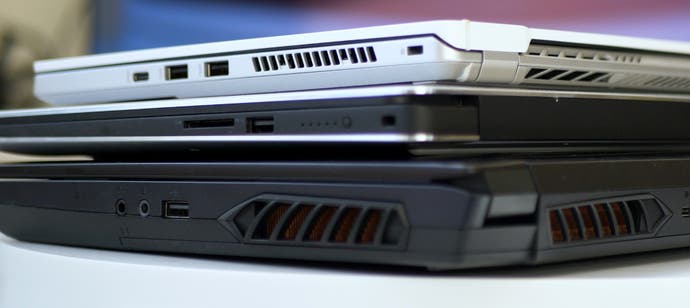
| 3950X Laptop | 3900 Laptop | 3900X Desktop | 3950X Desktop | 4900HS Laptop | |
|---|---|---|---|---|---|
| Cinebench R20 1T | 486 | 494 | 514 | 514 | 477 |
| Cinebench R20 MT | 7501 | 6474 | 7032 | 9249 | 4192 |
| Handbrake h.264 | 55.0fps | 44.8fps | 51.8fps | 64.7fps | 26.5fps |
| Handbrake HEVC | 20.4fps | 17.6fps | 20.3fps | 25.6fps | 9.5fps |
The video encoding tests are also astonishing. We encode 4K video in Handbrake using demanding h.264 and HEVC settings, inflicting crippling workloads where all cores are maxed for an extended period of time. In h.264, the laptop 3950X delivers 85 per cent of the desktop verson's output. The 3900 is about the same, with 86 performance of the 3900X's throughput. You'll note that the Ryzen 4000 results are once again annihilated by the Apex 15: prolonged all-core utilisation sees performance throttle back after a few minutes, massively reducing the average result. The Apex 15 simply doesn't do this: it's loud, it's proud and it powers on through at maximum speed right through to completion.
Gaming offers an entirely different challenge, however, with CPU utilisation that rarely soaks all cores but does use them in most cases. Core clocks are just as important as core count - probably more so, in fact. You can get a much better idea of gaming performance from the video review embedded above, but the headline stats are pretty straightforward. In raw performance terms, the Ryzen 9 3900 and 3950X in the laptop are only separated by a few percentage points and by and large, it's up there with a desktop Ryzen 5 3600X running with 3600MHz DDR4. By extention then, it'll be very close to a full desktop Ryzen 7 3700X in gaming prowess. The takeaway is pretty straightforward - it is desktop-class CPU performance and you're usually getting 90 per cent or more of the output of the same chip running in a desktop unit with faster memory. Comparisons against Ryzen 4000 Renoir are fascinating - we are clearly dealing with significantly higher performance here.
I tested by running my key benchmark games at 720p resolution, effectively removing the RTX 2070 from the equation as a limiting factor. However, the nature of the Apex 15's GPU is worth some examination - principally because it's the only element of the laptop you can't upgrade. What you're getting is the same silicon as the desktop version of the GPU, but it's downclocked to fit within a tighter power budget. The end result is that in most scenarios, performance is essentially point-for-point identical to the desktop RTX 2060. I did find it to be five per cent faster than the 2060 in The Witcher 3, but otherwise, it's on par. This makes the choice of a 1080p/144Hz screen more understandable, but I'd have preferred 1440p instead personally. One thing to bear in mind is that being an RTX 2070, you still get 8GB of GDDR6 memory - 2GB more than a desktop 2060. In the process, the biggest issue I have with the 2060 is eliminated.
Essentially, what we have here is a desktop replacement that delivers unprecedented mobile power by effectively delivering a miniaturised desktop PC. Graphics aside, you can upgrade it like a desktop, there's a ton of expandability in there and if you really push the spec with high-end processors and memory, you essentially have an eminently portable workstation that outperforms the vast majority of the modern desktop PCs out there. As the results came in on this machine, I continually marvelled at the performance. It's utterly insane.
It's almost like the anti-thesis of the Asus Zephyrus G14 I've been using as of late. In that case, Asus delivered an excellent 14-inch thin-and-light machine based on the ultra-efficient Ryzen 4000. The XMG Apex 15 lacks its refinement, its build quality and its form factor, but what you do get is a huge increase in processing power, hugely impressive expandability and an actual upgrade path to higher-end chips. I wish I'd had the time to try the Ryzen 5 3600 in this machine (the best-selling 65W processor around right now) but more than that, as it's based on the B450 chipset, there's a big chance that you'll also be able to upgrade to the more performant, potentially more efficient Zen 3 chips coming later this year.
The XMG Apex 15 is a remarkable machine then, but should you buy one? If you need a portable workstation with extreme CPU power, you're going to struggle to find anything better. I can think of numerous times we've had to encode video or edit 4K content at events like E3 or Gamescom where this machine would have made our lives so much easier. In fact, this notebook is more powerful than half of our in-house 4K editing machines - it can outperform a Ryzen 9 3900X, after all. However, on the flipside, it can't really be used as flexibly as a more conventional laptop: it really needs to be plugged in at all times. Gaming-wise, it's generally excellent but the RTX 2070 may be more of a limiting factor than the CPU, so a Comet Lake system with an RTX 2080 Super would likely be a better fit for the gamer.
Ultimately, this is a machine I really enjoyed testing for all manner of reasons. I like it because it speaks to the diversity of the PC hardware market and the way that manufacturers aren't afraid to push back the frontiers of what's possible. I love the notion that someone, somewhere decided to take a look at AMD's top-tier 16-core, 32-thread processor and dared to offer laptop support for it. Speaking to XMG over the last couple of months, I know there's been a fair degree of BIOS refinements and software tweaks going on behind the scenes to get this right. XMG has never tackled anything like this before so it is a first-gen effort in some respects. Some of the changes (eg throttling back for entertainment mode) speak to the experimental nature of this machine, but the end product as it stands right now does work - just go in accepting that if you want Palpatine levels of 'unlimited power', there's a price to pay in terms of thermals and acoustics. Beyond that though, the performance is mind-bending and this machine does actually work - and I'm still not entirely sure I quite believe it.
